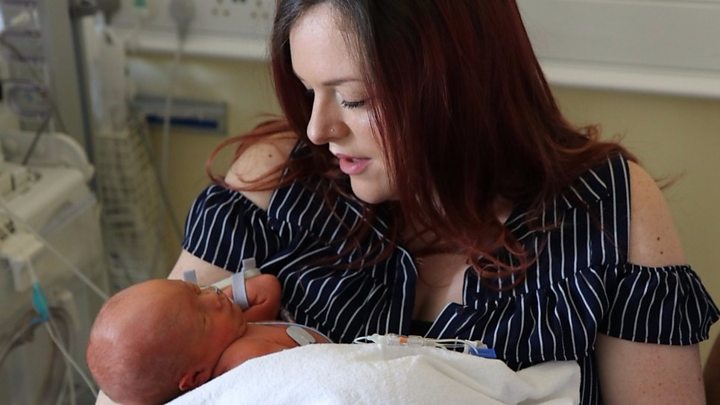Spina bifida: Keyhole surgery repairs baby spine in womb

Media playback is unsupported on your device
In a UK first, doctors have used keyhole surgery to repair the spine of a baby with spina bifida while it was still inside the womb.
Surgeons at King’s College Hospital say the procedure is not a cure, but could be the difference between some children learning to walk or not.
Sherrie Sharp and her son Jaxson had the operation 27 weeks into the pregnancy.
Spina bifida was diagnosed after the routine 20-week pregnancy scans.
They showed Jaxson’s spine and spinal cord were not forming correctly.
Gaps in the developing spine meant the cord was bulging out of his back and was left exposed to the amniotic fluid in the womb.
This damages the crucial nerves in the spinal cord and could lead to paralysis, a loss of sensation in the legs and problems controlling the bladder and bowels.
The longer the spinal cord is left exposed, the greater the damage.
Sherrie, 29, and from West Sussex, said the news was a shock, but an abortion was a “definite no”.
She decided to have pioneering surgery to correct the defect, although there was the risk of the baby arriving prematurely.
Sherrie told the BBC: “I wanted to do the best for my baby, I wanted him to have a better life and there’s nothing wrong with that.”
How the procedure worked
Doctors sedated Sherrie, and the anaesthetic also crossed the placenta to prevent Jaxson, who was still a tiny foetus at this point, from wriggling.
Surgeons made three small incisions in Sherrie’s bump and then a thin camera and small surgical tools were inserted into her womb.
Then, during a three-hour operation, surgeons put the exposed spinal cord back in place and used a patch to cover Jaxson’s spinal cord.
Dr Marta Santorum-Perez, a consultant at the Fetal Medicine Unit at King’s, told the BBC: “We are operating on very delicate structures – the foetus’s nerves.
“The foetus is very small and inside the womb, so obviously it’s a very delicate operation.”
Life-changing
Until recently, parents had to wait until a child was born for corrective surgery or find treatment abroad.
But the evidence suggests that operating during the second trimester reduces nerve damage and the long-term health consequences of spina bifida.
At the end of last year, the first in-womb surgery for spina bifida took place in the UK. It involved invasive surgery of opening the mother’s abdomen and uterus to perform the operation.
Mr Bassel Zebian, a consultant neurosurgeon at King’s, said the keyhole approach was better for the mother and reduced the risk of the uterus rupturing in subsequent pregnancies.
He said that operating in the womb also reduced the risk of complications later in life, but could not remove them entirely.
He told the BBC: “It’s quite important, because improving the function of the lower limbs may be the difference between someone walking and someone not walking later in life.
“So a significant improvement in a significant number of patients, but not a cure.”
Baby Jaxson arrived early, at 33 weeks, and was looked after in neonatal intensive care at King’s.
But Sherrie hopes the operation has given Jaxson the best start in life.
She said: “He’s got movements in his legs, we were told he’d have minimal movements if we didn’t have the surgery and he wouldn’t be able to move at all.
“I’ve got high hopes for him, from day one he’s done things, he’s amazed us all.
“He makes me proud every day, he’s just a miracle.”
Follow James on Twitter.

